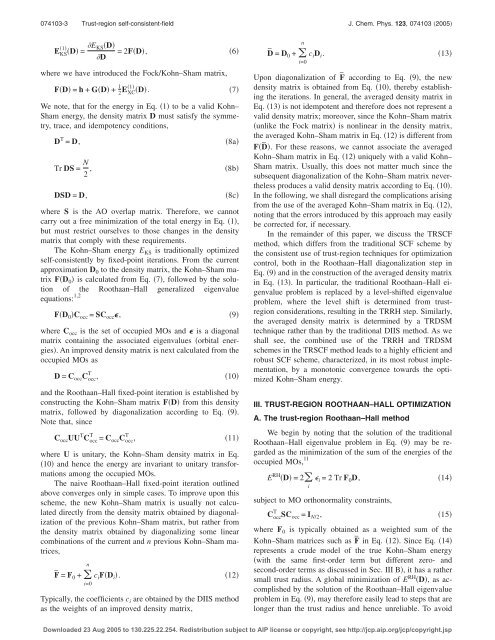Get my PhD Thesis
Get my PhD Thesis
Get my PhD Thesis
You also want an ePaper? Increase the reach of your titles
YUMPU automatically turns print PDFs into web optimized ePapers that Google loves.
074103-3 Trust-region self-consistent-field J. Chem. Phys. 123, 074103 2005<br />
E 1 KS D = E KSD<br />
=2FD, 6<br />
D<br />
where we have introduced the Fock/Kohn–Sham matrix,<br />
FD = h + GD + 1 2 E XC<br />
1 D.<br />
We note, that for the energy in Eq. 1 to be a valid Kohn–<br />
Sham energy, the density matrix D must satisfy the symmetry,<br />
trace, and idempotency conditions,<br />
D T = D,<br />
Tr DS = N 2 ,<br />
DSD = D,<br />
7<br />
8a<br />
8b<br />
8c<br />
where S is the AO overlap matrix. Therefore, we cannot<br />
carry out a free minimization of the total energy in Eq. 1,<br />
but must restrict ourselves to those changes in the density<br />
matrix that comply with these requirements.<br />
The Kohn–Sham energy E KS is traditionally optimized<br />
self-consistently by fixed-point iterations. From the current<br />
approximation D 0 to the density matrix, the Kohn–Sham matrix<br />
FD 0 is calculated from Eq. 7, followed by the solution<br />
of the Roothaan–Hall generalized eigenvalue<br />
equations: 1,2<br />
FD 0 C occ = SC occ ,<br />
where C occ is the set of occupied MOs and is a diagonal<br />
matrix containing the associated eigenvalues orbital energies.<br />
An improved density matrix is next calculated from the<br />
occupied MOs as<br />
D = C occ C T occ , 10<br />
and the Roothaan–Hall fixed-point iteration is established by<br />
constructing the Kohn–Sham matrix FD from this density<br />
matrix, followed by diagonalization according to Eq. 9.<br />
Note that, since<br />
C occ UU T C T<br />
occ = C occ C T occ , 11<br />
where U is unitary, the Kohn–Sham density matrix in Eq.<br />
10 and hence the energy are invariant to unitary transformations<br />
among the occupied MOs.<br />
The naive Roothaan–Hall fixed-point iteration outlined<br />
above converges only in simple cases. To improve upon this<br />
scheme, the new Kohn–Sham matrix is usually not calculated<br />
directly from the density matrix obtained by diagonalization<br />
of the previous Kohn–Sham matrix, but rather from<br />
the density matrix obtained by diagonalizing some linear<br />
combinations of the current and n previous Kohn–Sham matrices,<br />
n<br />
F¯ = F0 + c i FD i .<br />
12<br />
i=0<br />
Typically, the coefficients c i are obtained by the DIIS method<br />
as the weights of an improved density matrix,<br />
9<br />
n<br />
D¯ = D 0 + c i D i .<br />
i=0<br />
13<br />
Upon diagonalization of F¯ according to Eq. 9, the new<br />
density matrix is obtained from Eq. 10, thereby establishing<br />
the iterations. In general, the averaged density matrix in<br />
Eq. 13 is not idempotent and therefore does not represent a<br />
valid density matrix; moreover, since the Kohn–Sham matrix<br />
unlike the Fock matrix is nonlinear in the density matrix,<br />
the averaged Kohn–Sham matrix in Eq. 12 is different from<br />
FD¯ . For these reasons, we cannot associate the averaged<br />
Kohn–Sham matrix in Eq. 12 uniquely with a valid Kohn–<br />
Sham matrix. Usually, this does not matter much since the<br />
subsequent diagonalization of the Kohn–Sham matrix nevertheless<br />
produces a valid density matrix according to Eq. 10.<br />
In the following, we shall disregard the complications arising<br />
from the use of the averaged Kohn–Sham matrix in Eq. 12,<br />
noting that the errors introduced by this approach may easily<br />
be corrected for, if necessary.<br />
In the remainder of this paper, we discuss the TRSCF<br />
method, which differs from the traditional SCF scheme by<br />
the consistent use of trust-region techniques for optimization<br />
control, both in the Roothaan–Hall diagonalization step in<br />
Eq. 9 and in the construction of the averaged density matrix<br />
in Eq. 13. In particular, the traditional Roothaan–Hall eigenvalue<br />
problem is replaced by a level-shifted eigenvalue<br />
problem, where the level shift is determined from trustregion<br />
considerations, resulting in the TRRH step. Similarly,<br />
the averaged density matrix is determined by a TRDSM<br />
technique rather than by the traditional DIIS method. As we<br />
shall see, the combined use of the TRRH and TRDSM<br />
schemes in the TRSCF method leads to a highly efficient and<br />
robust SCF scheme, characterized, in its most robust implementation,<br />
by a monotonic convergence towards the optimized<br />
Kohn–Sham energy.<br />
III. TRUST-REGION ROOTHAAN–HALL OPTIMIZATION<br />
A. The trust-region Roothaan–Hall method<br />
We begin by noting that the solution of the traditional<br />
Roothaan–Hall eigenvalue problem in Eq. 9 may be regarded<br />
as the minimization of the sum of the energies of the<br />
occupied MOs, 11<br />
E RH D =2 i =2TrF 0 D,<br />
14<br />
i<br />
subject to MO orthonormality constraints,<br />
C T occ SC occ = I N/2 , 15<br />
where F 0 is typically obtained as a weighted sum of the<br />
Kohn–Sham matrices such as F¯ in Eq. 12. Since Eq. 14<br />
represents a crude model of the true Kohn–Sham energy<br />
with the same first-order term but different zero- and<br />
second-order terms as discussed in Sec. III B, it has a rather<br />
small trust radius. A global minimization of E RH D, asaccomplished<br />
by the solution of the Roothaan–Hall eigenvalue<br />
problem in Eq. 9, may therefore easily lead to steps that are<br />
longer than the trust radius and hence unreliable. To avoid<br />
Downloaded 23 Aug 2005 to 130.225.22.254. Redistribution subject to AIP license or copyright, see http://jcp.aip.org/jcp/copyright.jsp

















